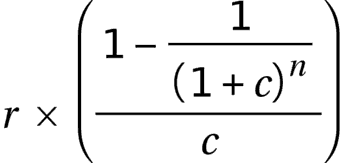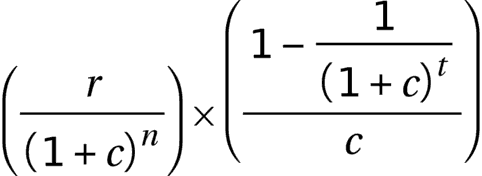Prospective
Part 7E+WDetermining the term value
IntroductionE+W
35(1)This Part of this Schedule contains provision for determining the term value in accordance with step 1 in paragraph 25.
(2)For the purposes of this Part of this Schedule, the rent under a lease is subject to a rent review if the lease or any other arrangement provides for the rent to change.
Lease not subject to a rent reviewE+W
36(1)This paragraph applies to a lease if the rent under the lease is not subject to a rent review at any time during the unexpired term of the lease.
(2)That includes a case where—
(a)the rent under the lease is subject to a rent review, but
(b)the terms of the rent review are such that there will be no further rent reviews during the unexpired term of the lease.
(3)The term value is determined using this formula—
where—
c is the applicable capitalisation rate;
r is the rent (but see sub-paragraph (4));
n is the length (in years) of the unexpired term of the lease.
(4)If paragraph 26(3) requires the notional annual rent to be used instead of the rent to determine the term value of the lease, r is the notional annual rent.
Lease subject to a rent review with fixed changesE+W
37(1)This paragraph applies to a lease if the rent under the lease is subject to a rent review which provides that, over the unexpired term of the lease—
(a)the rent will change each time one or more periods (a “review tranche”) begins,
(b)the length of the review tranche, or each of them, is known at the valuation date (and, in a case where there are two or more review tranches, it does not matter if they are the same or different lengths), and
(c)the amount by which the rent will change at the beginning of the review tranche, or each of them, is known or can be calculated at the valuation date (and, in a case where there are two or more review tranches, it does not matter if the amount of each change is the same or different).
(2)The term value is the sum of—
(a)the term value for the period (the “current tranche”) that begins with the valuation date and ends immediately before the start of the first (or only) review tranche after the valuation date, and
(b)the term value or values for each (or the) subsequent review tranche.
(3)The term value for the current tranche is determined using this formula—
where—
c is the applicable capitalisation rate;
r is the rent at the valuation date (but see sub-paragraph (4));
n is the length (in years) of the current tranche.
(4)If paragraph 26(3) requires the notional annual rent to be used instead of the rent at the valuation date to determine the term value of the lease, r is the notional annual rent.
(5)The term value for a review tranche (the “relevant review tranche”) is determined using this formula—
where—
c is the applicable capitalisation rate;
r is the rent during the relevant review tranche (but see sub-paragraph (6));
n is the length (in years) of the period that begins with the valuation date and ends with the day before the first day of the relevant review tranche.
t is the length (in years) of the relevant review tranche.
(6)If paragraph 26(3) requires the notional annual rent to be used instead of the rent during the relevant review tranche to determine the term value of the lease, r is the notional annual rent.
Lease subject to any other rent reviewE+W
38(1)This paragraph applies to a lease if—
(a)the rent under the lease is subject to a rent review, and
(b)paragraph 36 does not apply to the lease.
(2)The term value is determined using this formula—
where—
c is the applicable capitalisation rate;
r1 is the rent at the valuation date (but see sub-paragraph (6));
r2 is the rent after the first rent review following the valuation date (but see sub-paragraph (6));
n1 is the length (in years) of the period during which the rent at the valuation date will be payable;
n2 is the length (in years) of the period that begins with the first day of the first rent review following the valuation date and ends with the term date of the current lease.
(3)If the rent review provides for the rent under the lease to change by the same proportion as an index of price inflation or the capital or rental value of property, r2 is determined using this formula—
where—
a1 is the index of price inflation, or the capital or rental value, at the valuation date;
a2 is the index of price inflation, or the capital or rental value, at the time when the previous rent review took effect or (if none has taken effect) when the term of the lease began;
r1 is the rent at the valuation date;
(4)If the rent review provides for the rent under the lease to be a percentage or other proportion of the capital value of property, r2 is determined using this formula—
(5)If neither sub-paragraph (3) nor (4) applies to the rent review, r2 is to be determined in line with the terms of the rent review provision.
(6)If paragraph 26(3) requires the notional annual rent to be used—
(a)instead of the rent at the valuation date to determine the term value of the lease, r1 is the notional annual rent;
(b)instead of the rent after the first rent review following the valuation date, r2 is the notional annual rent.
InterpretationE+W
39(1)In this Part of this Schedule—
“applicable capitalisation rate”, in relation to any aspect of the determination of a term value, means the capitalisation rate prescribed in regulations made by the Secretary of State that is applicable to that aspect by virtue of the regulations — and for this purpose a “capitalisation rate” is a rate at which the entitlement to receive rent over the remainder of the term of a lease is capitalised;
“rent” has the same meaning as in the LR(GR)A 2022 (see section 22(2) and (3) of that Act);
“unexpired term”, in relation to a lease, means the period that—
(a)
begins with the valuation date, and
(b)
ends with the term date of the lease.
(2)A statutory instrument containing regulations under this paragraph is subject to the negative procedure.
(3)The Secretary of State must review the capitalisation rate or rates every ten years.






